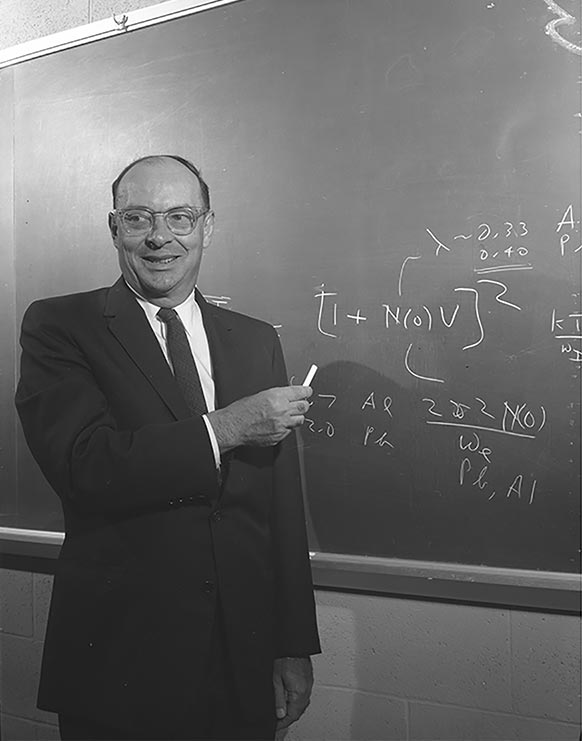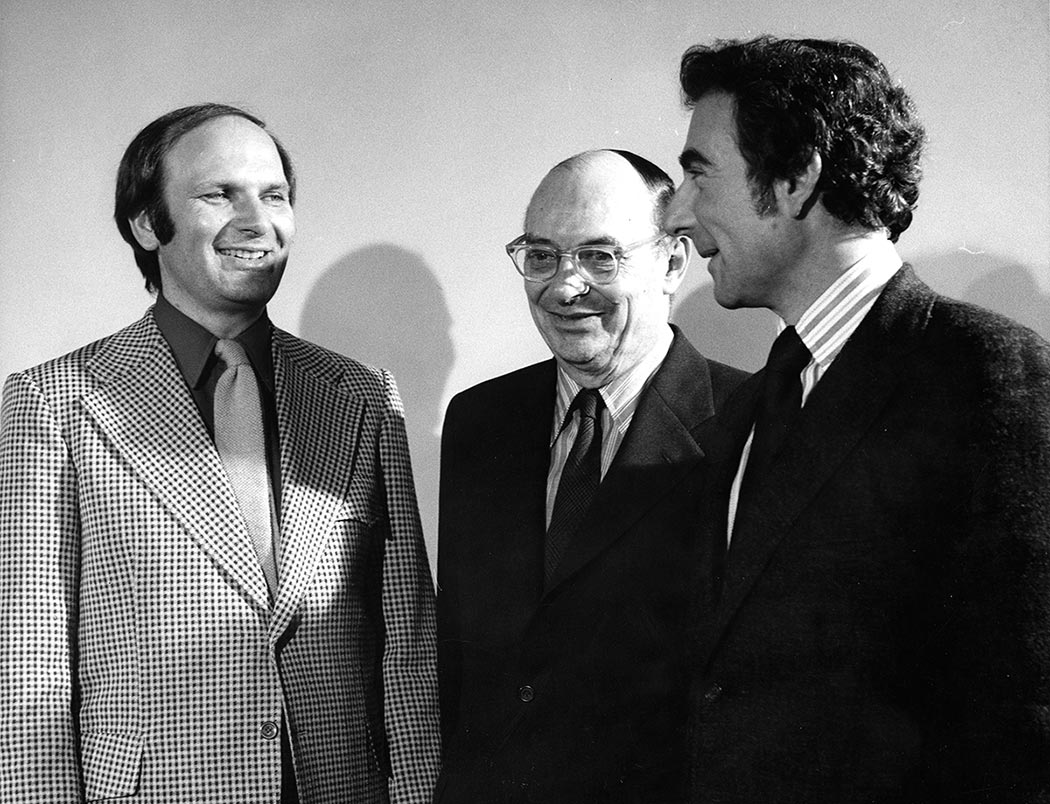Previous Bardeen Quad Tour Stop | Return to Bardeen Quad Tour Map
John Bardeen was born May 23, 1908 in Madison, Wisconsin. From a young age he was fascinated with engineering and mathematics, and pursued his interests at the University of Wisconsin. Although he took a semester off to work at the engineering department at Western Electric, he eventually graduated with a BS in electrical engineering in 1928. His BS was followed by a MS a year later (also from the University of Wisconsin).
John Bardeen, 1962
For the next twenty-two years, Bardeen would bounce from lab to lab all over the United States:
- 1930-1933 He worked at the Gulf Research Laboratories in Pittsburgh, Pennsylvania, working with magnetic and gravitational surveys.
- 1933-1936 Bardeen decided he was more interested in theoretical science and started graduate work in mathematical physics at Princeton where he became interested in solid state physics.
- 1935-1938 During his graduate studies, Bardeen also accepted a position as Junior Fellow of the Society of Fellows at Harvard University where he worked on cohesion and electrical conduction in metals.
- 1938-1941 Bardeen was assistant professor of Physics at the University of Minnesota.
- 1941 – 1945 During World War II, he worked at the Naval Ordnance Laboratory.
- 1945-1951 The next company Bardeen worked for was the Bell Telephone Laboratories conducting research in solid-state physics. It was here that Bardeen developed the first semiconductor transistor in 1947 with Walter Brattain and William P. Shockley.
- 1951 – 1975 Bardeen became a professor of electrical engineering and physics at University of Illinois and stayed at Illinois for the rest of his life.
Bardeen explaining an equation, 1963
Bardeen was able to establish two major programs while a professor at Illinois. The first was one in the Electrical Engineering Department which focused on experimental and theoretical aspects of semiconductors. The second program was in the Physics Department that looked at theoretical aspects of macroscopic quantum systems. This included superconductivity and quantum liquids.
John Bardeen with transistor prototype, 1988
In research, Bardeen was also a resounding success. His microscopic theory of superconductivity, developed in collaboration with L. N. Cooper and J. R. Schrieffer in 1956 and 1957, has had profound implications for nearly every field of physics from elementary particle, to nuclear and helium liquids, to neutron stars. Furthermore, in his nearly sixty year career, he made significant advancements to practically every aspect of condensed matter physics.
Bardeen is also recognized for being the only person to receive two Nobel Prizes in Physics. The first he received in 1956, which he shared then with William Shockley of Semiconductor Laboratory of Beckman Instruments and Walter Brattain of Bell Telephone Laboratories for their research and development of the semiconductor transistor and the transistor effect.
From left to right, John Robert Schrieffer , John Bardeen, and Leon Cooper who developed the BCS Theory regarding superconductivity, for which they were awarded the Nobel Prize in Physics in 1972, circa 1968.
In 1972, Bardeen received his second Nobel Prize shared with Leon N. Cooper of Brown University and John Robert Schrieffer of the University of Pennsylvania for their theory of superconductivity, known as the BCS-theory after their last names.
He continued to publish research up until his death at age eighty two on January 30th, 1991.
– Spurlock Museum. Bardeen’s Transistor Music Box. Directions: Enter the Europe exhibit on the 2nd floor, turn right upon entering and find the display case about communications. See the very first transistor radio, created by John Bardeen.
– Bardeen Quad. The south entrance by Green St. has a plaque describing Bardeen’s accomplishments.
– Bardeen Quad. Historical Marker located on the west end of the Bardeen Quad, near Engineering Hall and south of the creek.
– Grainger Engineering Library. Poster in the Engineering Hall of Fame on the second story.
– Loomis Lab. The central hallway of Loomis Lab contains reproductions of Bardeen’s Nobel Prizes. Directions: Enter through north or south entrances and walk straight. Display Case will be on the wall.
Board Of University of Illinois Trustees. (2013). John Bardeen. Physics Illinois. Retrieved March 7th, 2013 from http://physics.illinois.edu/people/memorials/bardeen.asp
John Bardeen Explaining an Equation. (1963, June). Photographic Subject File. Record Series 39/2/20, Box FAC – 4, Folder FAC – 4 Bardeen, John. University of Illinois Archives.
John Bardeen, Leon Cooper, and Robert Schrieffer. (1967). Photographic Subject File. Record Series 39/2/20, Box FAC – 4, Folder FAC – 4 Bardeen, John. University of Illinois Archives.
John Bardeen Portrait (1). (1962, Feb. 22). Faculty, Staff and Student Portraits, 1933-, Record Series 39/2/26, Box 4, Folder Bardeen, John. University of Illinois Archives.
John Bardeen with a Prototype Equipment. (1988, May). Photographic Subject File. Record Series 39/2/20, Box FAC – 4, Folder FAC – 4 Bardeen, John. University of Illinois Archives.
The Nobel Foundation. (2013). John Bardeen-Biographical. Retrieved on March 7th, 2013 from http://www.nobelprize.org/nobel_prizes/physics/laureates/1972/bardeen-bio.html




